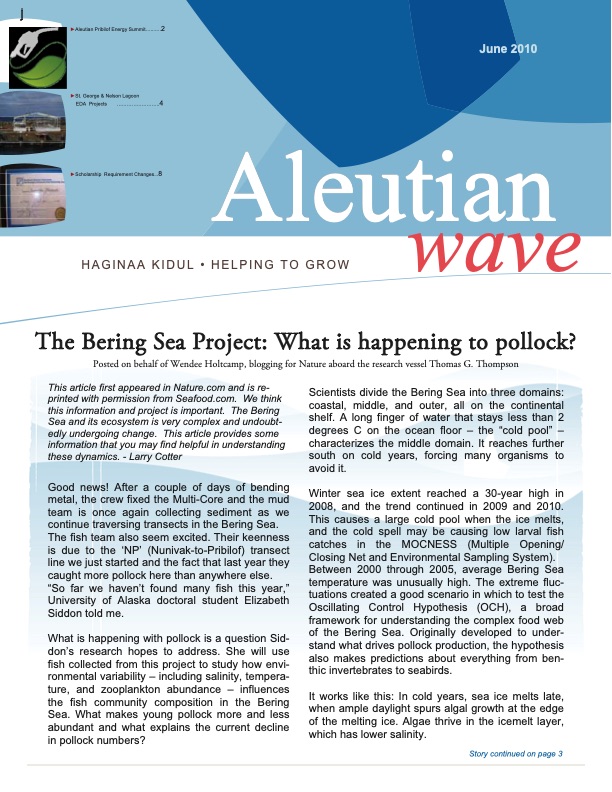
PDF Publication Title:
Text from PDF Page: 001
�Aleutian Pribilof Energy Summit..........2 �St. George & Nelson Lagoon EDA Projects ..........................4 June 2010 �Scholarship Requirement Changes...8 Aleutian Aleutian HAGINAA KIDUL • HELPING TO GROW wave The Bering Sea Project: What is happening to pollock? Posted on behalf of Wendee Holtcamp, blogging for Nature aboard the research vessel Thomas G. Thompson This article first appeared in Nature.com and is re- printed with permission from Seafood.com. We think this information and project is important. The Bering Sea and its ecosystem is very complex and undoubt- edly undergoing change. This article provides some information that you may find helpful in understanding these dynamics. - Larry Cotter Good news! After a couple of days of bending metal, the crew fixed the Multi-Core and the mud team is once again collecting sediment as we continue traversing transects in the Bering Sea. The fish team also seem excited. Their keenness is due to the ‘NP’ (Nunivak-to-Pribilof) transect line we just started and the fact that last year they caught more pollock here than anywhere else. “So far we haven’t found many fish this year,” University of Alaska doctoral student Elizabeth Siddon told me. What is happening with pollock is a question Sid- don’s research hopes to address. She will use fish collected from this project to study how envi- ronmental variability – including salinity, tempera- ture, and zooplankton abundance – influences the fish community composition in the Bering Sea. What makes young pollock more and less abundant and what explains the current decline in pollock numbers? Scientists divide the Bering Sea into three domains: coastal, middle, and outer, all on the continental shelf. A long finger of water that stays less than 2 degrees C on the ocean floor – the “cold pool” – characterizes the middle domain. It reaches further south on cold years, forcing many organisms to avoid it. Winter sea ice extent reached a 30-year high in 2008, and the trend continued in 2009 and 2010. This causes a large cold pool when the ice melts, and the cold spell may be causing low larval fish catches in the MOCNESS (Multiple Opening/ Closing Net and Environmental Sampling System). Between 2000 through 2005, average Bering Sea temperature was unusually high. The extreme fluc- tuations created a good scenario in which to test the Oscillating Control Hypothesis (OCH), a broad framework for understanding the complex food web of the Bering Sea. Originally developed to under- stand what drives pollock production, the hypothesis also makes predictions about everything from ben- thic invertebrates to seabirds. It works like this: In cold years, sea ice melts late, when ample daylight spurs algal growth at the edge of the melting ice. Algae thrive in the icemelt layer, which has lower salinity. Story continued on page 3PDF Image | The Bering Sea Project

PDF Search Title:
The Bering Sea ProjectOriginal File Name Searched:
June_2010WEB.pdfDIY PDF Search: Google It | Yahoo | Bing
NFT (Non Fungible Token): Buy our tech, design, development or system NFT and become part of our tech NFT network... More Info
IT XR Project Redstone NFT Available for Sale: NFT for high tech turbine design with one part 3D printed counter-rotating energy turbine. Be part of the future with this NFT. Can be bought and sold but only one design NFT exists. Royalties go to the developer (Infinity) to keep enhancing design and applications... More Info
Infinity Turbine IT XR Project Redstone Design: NFT for sale... NFT for high tech turbine design with one part 3D printed counter-rotating energy turbine. Includes all rights to this turbine design, including license for Fluid Handling Block I and II for the turbine assembly and housing. The NFT includes the blueprints (cad/cam), revenue streams, and all future development of the IT XR Project Redstone... More Info
Infinity Turbine ROT Radial Outflow Turbine 24 Design and Worldwide Rights: NFT for sale... NFT for the ROT 24 energy turbine. Be part of the future with this NFT. This design can be bought and sold but only one design NFT exists. You may manufacture the unit, or get the revenues from its sale from Infinity Turbine. Royalties go to the developer (Infinity) to keep enhancing design and applications... More Info
Infinity Supercritical CO2 10 Liter Extractor Design and Worldwide Rights: The Infinity Supercritical 10L CO2 extractor is for botanical oil extraction, which is rich in terpenes and can produce shelf ready full spectrum oil. With over 5 years of development, this industry leader mature extractor machine has been sold since 2015 and is part of many profitable businesses. The process can also be used for electrowinning, e-waste recycling, and lithium battery recycling, gold mining electronic wastes, precious metals. CO2 can also be used in a reverse fuel cell with nafion to make a gas-to-liquids fuel, such as methanol, ethanol and butanol or ethylene. Supercritical CO2 has also been used for treating nafion to make it more effective catalyst. This NFT is for the purchase of worldwide rights which includes the design. More Info
NFT (Non Fungible Token): Buy our tech, design, development or system NFT and become part of our tech NFT network... More Info
Infinity Turbine Products: Special for this month, any plans are $10,000 for complete Cad/Cam blueprints. License is for one build. Try before you buy a production license. May pay by Bitcoin or other Crypto. Products Page... More Info
| CONTACT TEL: 608-238-6001 Email: greg@infinityturbine.com | RSS | AMP |